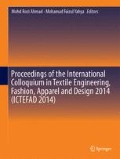Abstract
The aim of this work was to investigate the characteristics of polyvinyl alcohol (PVA) nanofibres with the incorporation of Aloe vera as a novel polymer-drug carrier. The nanofibres were produced via the electrospinning technique. The morphological structure and properties were characterized using field emission scanning electron microscopy (FESEM), Fourier transform infrared spectroscopy (FTIR) and differential scanning calorimetry (DSC). The FESEM image shows homogenous and linear fibre when PVA is mixed with Aloe vera. The average size was 123 nm, smaller than the PVA nanofibre. The presence of aloin in DSC showed that the Aloe vera was successfully embedded within the PVA nanofibre.
Access this chapter
Tax calculation will be finalised at checkout
Purchases are for personal use only
References
T. Subbiah, G.S. Bhat, R.W. Tock, S. Parameswaran, S. Ramkumar, Electrospinning of nanofibers. J. Appl. Polym. Sci. 96(2), 557–569 (2005)
R. Barhate, C. Loong, S. Ramakrishna, Preparation and characterization of nanofibrous filtering media. J. Membr. Sci. 283, 209–218 (2006)
A. Frenot, I.S. Chronakis, Polymer nanofibers assembled by electrospinning. Curr. Opin. Colloid Interface Sci. 8(1), 64–75 (2003)
S. Tan, X. Huang, B. Wu, Some fascinating phenomena in electrospinning processes and applications of electrospun nanofibers. Polym. Int. 56(11), 1330–1339 (2007)
C. Feng, K. Khulbe, T. Matsuura, Recent progress in the preparation, characterization, and applications of nanofibers and nanofiber membranes via electrospinning/interfacial polymerization. J. Appl. Polym. Sci. 115(2), 756–776 (2010)
P. Lu, B. Ding, Applications of electrospun fibers. Recent Patents Nanotechnol. 2(3), 169–182 (2008)
S. Ramakrishna, K. Fujihara, W. Teo, T. Lim, Z. Ma, An Introduction to Electrospinning and Nanofibers (World Scientific, Singapore, 2005)
A.P.S. Sawhney, B. Condon, K.V. Singh, S.S. Pang, G. Li, H. David, Modern applications of nanotechnology in textile. Text. Res. J. 78(8), 731 (2008)
D.R. Salem, Structure Formation in Polymeric Fibers (Hanser Publishers, Munich, 2001)
O.O. Dosunmu, G.G. Chase, J. Varabhas, W. Kataphinan, D. Reneker, Polymer nanofibers from multiple jets produced on a porous surface by electrospinning. Nanotechnology 17(4), 1123–1127 (2006)
N. Affandi, Y. Truong, I. Kyratzis, R. Padhye, L. Arnold, A non-destructive method for thickness measurement of thin electrospun membranes using white light profilometry. J. Mater. Sci. 45, 1411–1418 (2010)
N.D. Nor Affandi, M.R. Ahmad, A. Baharudin, N.A. Abdullah Shukry, Effect of crosslinking on the solubility and morphological structures of the PVA nanofibres. Paper presented at the humanities, IEEE colloquium on science and engineering (CHUSER) (2012)
E.R. Kenawy, F.I. Abdel-Hay, M.H. El-Newehy, G.E. Wnek, Controlled release of ketoprofen from electrospun poly (vinyl alcohol) nanofibers. Mater. Sci. Eng. A 459, 390–396 (2007)
J. Zeng, L. Yang, Q. Liang, X. Zhang, H. Guan, X. Xu, X. Jing, Influence of the drug compatibility with polymer solution on the release kinetics of electrospun fiber formulation. J. Control. Release 105(1), 43–51 (2005)
I. Uslu, S. Keskin, A. Gül, T.C. Karabulut, M.L. Aksu, Preparation and properties of electrospun poly (vinyl alcohol) blended hybrid polymer with Aloe vera and HPMC as wound dressing. Hacettepe J. Biol. Chem. 38, 19–25 (2010)
P. Taepaiboon, U. Rungsardthong, P. Supaphol, Drug-loaded electrospun mats of poly (vinyl alcohol) fibres and their release characteristics of four model drugs. Nanotechnology 17(9), 2317 (2006)
N. Bölgen, Y.Z. Menceloğlu, K. Acatay, I. Vargel, E. Pişkin, In vitro and in vivo degradation of non-woven materials made of poly (ε-caprolactone) nanofibers prepared by electrospinning under different conditions. J. Biomater. Sci. Polym. Ed. 16(12), 1537–1555 (2005)
E. Yang, X. Qin, S. Wang, Electrospun crosslinked polyvinyl alcohol membrane. Mater. Lett. 62(20), 3555–3557 (2008)
J.H. Hamman, Composition and applications of Aloe vera leaf gel. Molecules 13(8), 1599–1616 (2008)
R. Haniadka, P. Kamble, A. Azmidha, P.P. Mane, Geevarughese, P.L. Palatty, M.S. Baliga, in Review on the Use of Aloe vera (Aloe) in Dermatology. Bioactive Dietary Factors and Plant Extracts in Dermatology (Springer, New York, 2013), pp. 125–133
X. Li, M.A. Kanjwal, L. Lin, I.S. Chronakis, Electrospun polyvinyl-alcohol nanofibers as oral fast-dissolving delivery system of caffeine and riboflavin. Colloids Surf. B Biointerfaces 103, 182 (2012)
S. Ravi, P. Kabilar, S. Velmurugan, R.A. Kumar, M. Gayathiri, Spectroscopy studies on the status of aloin in Aloe vera and commercial samples. J. Exp. Sci. 2(8), 10–13 (2011)
A.J. Amalraj, J.W. Sahayaraj, C. Kumar, S. Rajendran, A.P.P. Regis, S.K. Selvaraj, R. Mohan, Corrosion inhibitor Aloe vera – Nickel system controlling the corrosion of carbon steel in rain water, 315–319 (2013)
C.I. Nindo, J.R. Powers, J. Tang, Thermal properties of Aloe vera powder and rheology of reconstituted gels. Trans. ASABE 53(4), 1193–120 (2010)
Acknowledgement
The authors would like to acknowledge the grant provided by the Ministry of Education through the Exploratory Research Grant Scheme (ERGS). The assistance from the Research Management Institute (RMI) of Universiti Teknologi MARA is greatly appreciated.
Author information
Authors and Affiliations
Corresponding author
Editor information
Editors and Affiliations
Rights and permissions
Copyright information
© 2014 Springer Science+Business Media Singapore
About this paper
Cite this paper
Abdullah@Shukry, N.A., Ahmad Sekak, K., Ahmad, M.R., Bustami Effendi, T.J. (2014). Characteristics of Electrospun PVA-Aloe vera Nanofibres Produced via Electrospinning. In: Ahmad, M., Yahya, M. (eds) Proceedings of the International Colloquium in Textile Engineering, Fashion, Apparel and Design 2014 (ICTEFAD 2014). Springer, Singapore. https://doi.org/10.1007/978-981-287-011-7_2
Download citation
DOI: https://doi.org/10.1007/978-981-287-011-7_2
Published:
Publisher Name: Springer, Singapore
Print ISBN: 978-981-287-010-0
Online ISBN: 978-981-287-011-7
eBook Packages: Chemistry and Materials ScienceChemistry and Material Science (R0)

